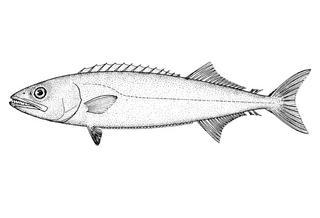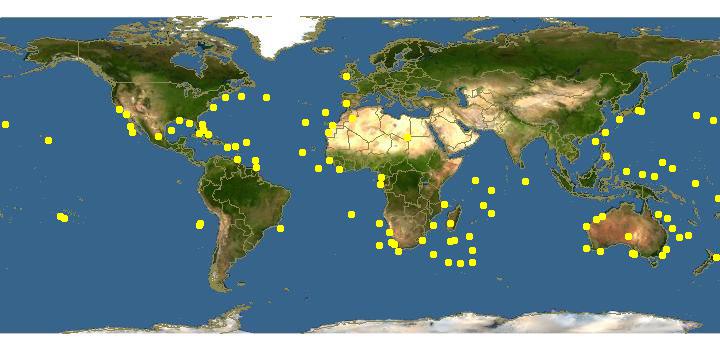
www.fao.org Copyright Michel Lamboeuf · 0
Ruvettus pretiosus |

Click on map for details about points.
|
| Links |
We parsed the following live from the Web into this page. Such content is managed by its original site and not cached on Discover Life. Please send feedback and corrections directly to the source. See original regarding copyrights and terms of use.
- Australian Faunal Directory
- FishBase
|
|
espa˝ol |
|
|
Overview |
Main identification features
- elongate, compressed; large eye
- black
- dorsal fin and a: 2 finlets behind;1ll
- belly - keel of rigid scales
- small spines between smooth scales
Oilfish
Elongate, slightly compressed; head pointed; eye large, circular; mouth at front, large, ends behind eye; 1 row large teeth each jaw, canines at front; belly with keel of bony plates along midline; 1st dorsal low, long, XIII-XV spines; 2nd dorsal higher 15-18 rays, 2 finlets behind; anal 15-18 rays, 2 finlets behind; tail broadly forked, no keels on tail base; pelvics well developed, under pectorals; scales smooth, with rows of small spines in between them; lateral line with slight curve over pectoral, straight to tail base.
Uniform dark purplish brown to brown; tips of pectoral and pelvic black; juvenile with margins of 2nd dorsal and anal white.
Size: 305 cm.
Habitat: Oceanic; midwater pelagic.
Depth: 50-1160 m.
Circumglobal, temperate to tropical, California to outer Baja, Guatemala to Panama, Ecuador to Peru, Malpelo.
Attributes
Abundance: Common.
Cites: Not listed.
Climate Zone: North Temperate (Californian Province &/or Northern Gulf of California); Northern Tropical (Mexican Province to Nicaragua + Revillagigedos); Equatorial (Costa Rica to Ecuador + Galapagos, Clipperton, Cocos, Malpelo); South Temperate (Peruvian Province ).
Depth Range Max: 1160 m.
Depth Range Min: 50 m.
Diet: bony fishes; Pelagic crustacea; octopus/squid/cuttlefish.
Eastern Pacific Range: Northern limit=34; Southern limit=-6; Western limit=-118; Eastern limit=-78; Latitudinal range=40; Longitudinal range=40.
Egg Type: Pelagic; Pelagic larva.
Feeding Group: Carnivore.
FishBase Habitat: Bentho-Pelagic.
Global Endemism: Circumtropical ( Indian + Pacific + Atlantic Oceans); East Pacific + Atlantic (East +/or West); East Pacific + all Atlantic (East+West); TEP non-endemic; All species.
Habitat: Water column.
Inshore Offshore: Offshore; Offshore Only.
IUCN Red List: Not evaluated / Listed.
Length Max: 305 cm.
Regional Endemism: Island (s); Continent; Continent + Island (s); Tropical Eastern Pacific (TEP) non-endemic; Eastern Pacific non-endemic; All species.
Residency: Resident.
Salinity: Marine; Marine Only.
Water Column Position: Mid Water; Near Surface; Surface; Water column only;
|
|
|
Names | |
|
|
|
Links to other sites | |
|
|
|
References |
- Briggs, J.C., 1960., Fishes of worldwide (circumtropical) distribution., Copeia, 1960:171-180.
- BÚarez, P., 1996., Lista de los Peces Marinos del Ecuador Continental., Revista de Biologia Tropical, 44:731-741.
- Cocco,., 1833., Cenni sul genere Ruvettus e sui caratteri che lo distinguone., Osservationes Peloritani, 8:18.
- Eschmeyer , W. N. , Herald , E. S. and Hamman, H., 1983., A field guide to Pacific coast fishes of North America from the Gulf of Alaska to Baja California. Peterson Field Guide Ser. 28., Houghton Mifflin:336pp.
- Fischer , W. , Krup , F. , Schneider , W. , Sommer , C. , Carpenter , K. E. and Niem, V. H., 1995., Guia FAO para la Identificacion de Especies de para los fines de la Pesca. Pacifico Centro-Oriental. Volumen II. Vertebrados - Parte 1., FAO2:647-1200.
- Jimenez-Prado, P., BÚarez, P., 2004., Peces marinos del Ecuador continental / Marine fishes of continental Ecuador., SIMBIOE/NAZCA/IFEA tomo 1 y 2.
- Lopez , M. I. and Bussing, W. A., 1982., Lista provisional de los peces marinos de la Costa Rica., Revista de Biologia Tropical, 30(1):5-26.
- Love, M.S., Mecklenburg, C.W., Mecklenburg, T.A., Thorsteinson, L.K., 2005., es of the West Coast and Alaska: a checklist of North Pacific and Artic Ocena species from Baja California to the Alaska-Yukon border., U.S. Department of the Interior, U.S. Geological Survey, Biological Resources Division, 288pp.
- Rubio, E.A., 1988., Estudio taxonomico de la ictiofauna acompa˝ante del camaron en areas costeras del Pacifico de Colombia., Memorias del VI Seminario Nacional de las Ciencias del Mar. Comisiˇn Colombiana de OceanografÝa. Bogota, Colombia., :169-183.
- Van der Heiden , A. M. and Findley, L. T., 1988., Lista de los peces marinos del sur de Sinaloa, MÚxico., Anales del Centro de Ciencias del Mar y Limnologia de la Universidad Autonoma Nacional de Mexico, 15:209-224.
|
|
|
Acknowledgements | |
I thank Ashley MacDonald and John Pickering, University of Georgia, for technical support in building this page.
|
|
| Supported by | |
|
Following modified from Australian Faunal Directory
|
Top | See original
| &pull 20q v5.145 20180528: Error 301 Moved Permanently http://biodiversity.org.au/afd/taxa/bafc5a30-0f60-4dc7-aa18-ed0189fc12c9 |
|
Following modified from FishBase
|
Top | See original
http://www.fishbase.org/Summary/speciesSummary.php?genusname=Ruvettus&speciesname=pretiosus ---> http://192.134.151.83/Summary/speciesSummary.php?genusname=Ruvettus&speciesname=pretiosus
http://192.134.151.83/Summary/speciesSummary.php?genusname=Ruvettus&speciesname=pretiosus ---> https://fishbase.mnhn.fr/Summary/speciesSummary.php?genusname=Ruvettus&speciesname=pretiosus
https://fishbase.mnhn.fr/Summary/speciesSummary.php?genusname=Ruvettus&speciesname=pretiosus ---> https://fishbase.mnhn.fr/summary/Ruvettus-pretiosus.html
Ruvettus pretiosus, Oilfish : fisheries, gamefish

You can
sponsor
this page
Common name (e.g. trout)
Genus + Species (e.g. Gadus morhua)
-

-
About this page
-
Languages
-
User feedbacks
-
Citation
-
Uploads
-
Related species
-


 Oilfish
Add your observation in
Fish Watcher
Upload your
photos
and
videos
Oilfish
Add your observation in
Fish Watcher
Upload your
photos
and
videos
Pictures
|
Google image
 Ruvettus pretiosus
Ruvettus pretiosus
Female picture by
Cambraia Duarte, P.M.N. (c)ImagDOP
Teleostei (teleosts) >
Scombriformes
(Mackerels) >
Gempylidae
(Snake mackerels)
Etymology:
Environment: milieu / climate zone / depth range / distribution range
Ecology
Marine; benthopelagic; oceanodromous (Ref.
51243
); depth range 100 - 975 m (Ref.
9302
), usually 200 - 400 m (Ref.
6181
). Subtropical; 55°N - 43°S, 180°W - 180°E (Ref.
6181
)
Circumtropical and temperate seas of the world.
Size / Weight / Age
Maturity: L
m
?
range ? - ? cm
Max length : 300 cm TL male/unsexed; (Ref.
5951
); common length : 150 cm SL male/unsexed; (Ref.
6181
); max. published weight: 63.5 kg (Ref.
4699
)
Dorsal
spines
(total): 13 - 15;
Dorsal
soft rays
(total): 15-18;
Anal
spines
: 0;
Anal
soft rays
: 15 - 18;
Vertebrae
: 32. Skin very rough, scales interspersed with spinous bony tubercles. Mid-ventral (abdominal) keel on the ventral contour. Body is uniformly brown to dark brown, tips of the pectoral and pelvic fins black, margins of the second dorsal and anal fins white in young specimens.
Usually over the continental shelf, sometimes in oceanic waters down to 800 m (Ref.
9302
). Usually solitary or in pairs near the bottom (Ref.
6181
). Migrates far offshore (Ref.
26139
). Pelagic (Ref.
5951
). Feeds on fish, crustaceans and squid (Ref.
6181
). The peculiar wooden 'palu' or
Ruvettus
hook is used to catch this species in south central Pacific (Ref.
6181
). The flesh is very oily, with purgative properties, if eaten much (Ref.
6181
). Marketed fresh and as fish cakes in Japan (Ref.
9302
); also processed into fishmeal (Ref.
5217
). Maximum length reported to reach up to 2 m only (Heemstra, pers. comm. 03/03).
Life cycle and mating behavior
Maturity
|
Reproduction
|
Spawning
|
Eggs
|
Fecundity
|
Larvae
Nakamura, I. and N.V. Parin
, 1993. FAO Species Catalogue. Vol. 15. Snake mackerels and cutlassfishes of the world (families Gempylidae and Trichiuridae). An annotated and illustrated catalogue of the snake mackerels, snoeks, escolars, gemfishes, sackfishes, domine, oilfish, cutlassfishes,. scabbardfishes, hairtails, and frostfishes known to date. FAO Fish. Synop. 125(15):136 p. (Ref.
6181
)
IUCN Red List Status (Ref.
130435
)
Least Concern (LC)
; Date assessed:
22 August 2012
CITES
Not Evaluated
Not Evaluated
Threat to humans
Poisonous to eat (Ref.
4690
)
Human uses
Fisheries: minor commercial; gamefish: yes
FAO - Fisheries:
landings
; Publication:
search
| FIRMS -
Stock assessments
|
FishSource
|
Sea Around Us
More information
Countries
FAO areas
Ecosystems
Occurrences
Introductions
Stocks
Ecology
Diet
Food items
Food consumption
Ration
Common names
Synonyms
Metabolism
Predators
Ecotoxicology
Reproduction
Maturity
Spawning
Spawning aggregation
Fecundity
Eggs
Egg development
Age/Size
Growth
Length-weight
Length-length
Length-frequencies
Morphometrics
Morphology
Larvae
Larval dynamics
Recruitment
Abundance
BRUVS
References
Aquaculture
Aquaculture profile
Strains
Genetics
Electrophoreses
Heritability
Diseases
Processing
Nutrients
Mass conversion
Collaborators
Pictures
Stamps, Coins Misc.
Sounds
Ciguatera
Speed
Swim. type
Gill area
Otoliths
Brains
Vision
Tools
E-book
|
Field guide
|
Identification keys
|
Length-frequency wizard
|
Life-history tool
|
Point map
|
Classification Tree
|
Catch-MSY
|
Special reports
Check for Aquarium maintenance
|
Check for Species Fact Sheets
|
Check for Aquaculture Fact Sheets
Download XML
Summary page
|
Point data
|
Common names
|
Photos
Internet sources
AFORO (otoliths)
|
Aquatic Commons
|
BHL
|
Cloffa
|
BOLDSystems
|
Websites from users
|
Check FishWatcher
|
CISTI
|
Catalog of Fishes
:
genus
,
species
|
DiscoverLife
|
ECOTOX
| FAO - Fisheries:
landings
; Publication:
search
|
Faunafri
| Fishipedia |
Fishtrace
| GenBank:
genome
,
nucleotide
|
GloBI
|
Google Books
|
Google Scholar
|
Google
|
IGFA World Record
|
MitoFish
|
National databases
|
Otolith Atlas of Taiwan Fishes
|
PubMed
| Reef Life Survey |
RFE Identification
| Socotra Atlas |
Tree of Life
| Wikipedia:
Go
,
Search
| World Records Freshwater Fishing |
Zoobank
|
Zoological Record
Estimates based on models
Preferred temperature (Ref.
123201
): 8.6 - 19, mean 12.9 °C (based on 603 cells).
Phylogenetic diversity index (Ref.
82804
): PD
50
= 1.0000 [Uniqueness, from 0.5 = low to 2.0 = high].
Bayesian length-weight: a=0.00347 (0.00191 - 0.00629), b=3.10 (2.93 - 3.27), in cm total length, based on LWR estimates for this species & (Sub)family-body (Ref.
93245
).
Trophic level (Ref.
69278
): 4.2 ±0.57 se; based on food items.
Resilience (Ref.
120179
): Low, minimum population doubling time 4.5 - 14 years (Assuming tm>4).
Prior r = 0.28, 95% CL = 0.16 - 0.49, Based on 1 stock assessment.
Fishing Vulnerability (Ref.
59153
): Very high vulnerability (90 of 100).
Climate Vulnerability (Ref.
125649
): Moderate vulnerability (38 of 100).
Price category (Ref.
80766
):
Medium
.
Nutrients (Ref.
124155
): Calcium = 17.3 [7.8, 32.2] mg/100g; Iron = 0.573 [0.271, 1.108] mg/100g; Protein = 17.7 [15.5, 19.7] %; Omega3 = 0.202 [0.110, 0.353] g/100g; Selenium = 81.8 [36.6, 171.9] ╬╝g/100g; VitaminA = 10.3 [3.2, 36.7] ╬╝g/100g; Zinc = 0.411 [0.288, 0.611] mg/100g (wet weight);
Back to Search
Random Species
Back to Top
Accessed through:
Not available
FishBase mirror site :
localhost
Page last modified by :
mrius-barile
- 20 July 2016
Fatal error
: Uncaught ArgumentCountError: Too few arguments to function checkEcotox(), 1 passed in /var/www/html/summary/speciessummary.php on line 2304 and exactly 3 expected in /var/www/html/includes/speciessummary.lib.php:2579 Stack trace: #0 /var/www/html/summary/speciessummary.php(2304): checkEcotox() #1 {main} thrown in
/var/www/html/includes/speciessummary.lib.php
on line
2579
|
Updated: 2024-04-19 13:12:18 gmt
|